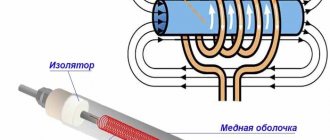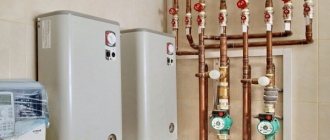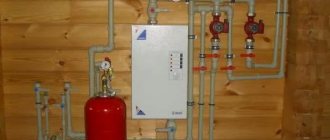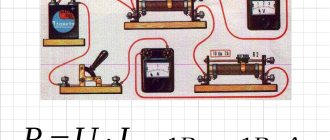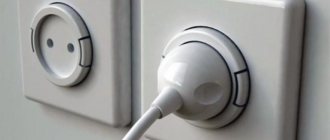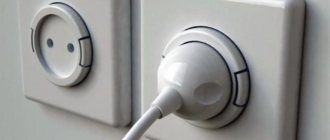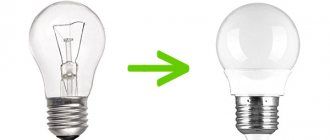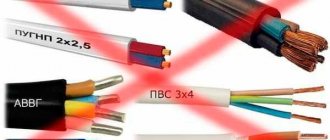Home / Electric boilers
Back
Published: 01/09/2020
Reading time: 2 min
0
12999
The use of electricity as a primary source of energy for heating a country cottage is interesting for many reasons: easy accessibility, general prevalence, environmental safety.
At the same time, the key obstacle to the use of electric boilers is the very high cost of electrical energy.
Nevertheless, there are options to bring high costs to normal if you understand what factors determine the energy consumption for heating, be able to calculate how much an electric boiler consumes and know real ways to reduce heat losses.
- 1 What does power consumption depend on?
- 2 Calculation of electricity consumption by the boiler per day and per month 2.1 Consumption based on m2 of house area
Methods for calculating the power of an electric boiler
There are two main methods for calculating the required power of an electric boiler.
The first is based on the heated area, the second on the calculation of heat loss through the building envelope. The calculation according to the first option is very rough, based on a single indicator - specific power. Specific power is given in reference books and depends on the region.
The calculation for the second option is more complicated, but takes into account many individual indicators of a particular building. A complete thermal engineering calculation of a building is a rather complex and painstaking task. Next, a simplified calculation will be considered, which nevertheless has the necessary accuracy.
Regardless of the calculation method, the quantity and quality of the collected initial data directly affect the correct assessment of the required power of the electric boiler.
With reduced power, the equipment will constantly operate at maximum load, not providing the necessary living comfort. With overestimated power, there is an unreasonably large consumption of electricity and a high cost of heating equipment.
Unlike other types of fuel, electricity is an environmentally friendly, fairly clean and simple option, but is tied to the presence of an uninterrupted power grid in the region
Boiler types
Electric boilers are distinguished by four main characteristics:
- Power. Electricity consumption depends on it.
- Device. An electric boiler can heat the coolant in different ways: heating elements (efficiency up to 95%), induction heating (efficiency up to 98%), electrode (efficiency up to 98%).
- Number of circuits – 1 or 2.
- Construction (boiler room or not).
The choice depends on your requirements and preferences; double-circuit boilers will provide you not only with heating, but also with hot water. Boiler rooms are more economical, with heating elements they are easy to repair, and with electrodes they are more efficient. You can learn more about how to choose an electric boiler from our separate article by following the link.
Factors that reduce energy consumption
As already mentioned, when installing electric heated floors in all rooms of the apartment, the payment costs will be impressive, which will affect your family budget.
However, there are ways to reduce energy consumption:
- Carrying out high-quality insulation - good thermal insulation reduces consumption by 35 - 40%.
- Installing a multifunctional meter - the cost of electricity used at night is about 2 times lower. Moreover, heating mainly works when there are people in the house, and this is usually in the evening and night.
- Installation of heated floors should be carried out in a free area. Laying it under furniture is not only unprofitable, but also prohibited by the system manufacturer.
- Use of finishing coatings with a good degree of thermal conductivity.
- Installing a programmable thermostat, especially in residential areas, will allow you to save a third on energy.
- In sparsely inhabited rooms, not maintaining a high degree of heating is an unnecessary waste of energy.
Climatic conditions are also of great importance. The greater the difference between the temperature in the room and outside the window, the power consumption of electricity increases.
Thermostat is an indispensable device for reducing costs
Separately, it should be said about the thermostat - its use can reduce energy consumption by up to 40%. It is recommended to install the device in the coldest place in the room. When the temperature drops below the set value, it will turn on the heating, and when the desired value is reached, it will turn off.
In many ways, electricity consumption is influenced by the type of thermostat, they are:
- mechanical - the design is simple and inexpensive, the daily working time is about 12 hours;
- programmable - equipped with several modes that allow you to control operation; such a device operates only 6 hours a day.
Using an example, we will consider which type of thermostat will be more economical. To do this we use the formula:
Рд = t * Ptot;
t—device operating time;
Ptot—power.
When installing a mat with a voltage of 900 W, and using a mechanical type regulator:
Pd = t * Ptot = 12 h * 900 W = 10,800 W = 10.8 kW
If a software controller is installed, then:
Pd= t * Ptot = 6 h * 900 W = 5,400 W = 5.4 kW
From this calculation it is clear that the use of a programmable controller will significantly reduce your costs.
If the warm floor acts as the main heating in all rooms, then the installation of several regulators will be required, which are connected to one centralized system.
When thinking about installing an electric floor in a house or apartment, you should make all the required calculations, taking into account the maximum load in winter. Only after weighing all the pros and cons, you need to make a decision about installing such a structure.
The feasibility of purchasing electric boilers
Despite these advantages, we do not claim that electric boilers are the best and most universal way to heat a home. It all depends on the circumstances.
Let's try to answer the question of who benefits from using electric boilers and when.
- When gas is not supplied. Gas is the cheapest fuel, and heating a house with it is much more economical than using electricity. But in areas remote from the gas main, or lack of budget or time to connect gas, electric boilers will be a quick and inexpensive (but not operational) solution.
- When the house is very well insulated. The amount of heat required to heat a room directly depends on heat losses - they need to be blocked. With small heat losses, heating with electricity takes place. Although gas would still be cheaper))
- If you rarely visit the house - for example, at a dacha or in a country house. Modern models of electric boilers are able to maintain a given temperature - you can set the minimum temperature at which the heating system will not freeze, and when you are about to arrive, give a signal to the boiler that you need to warm the house to a comfortable temperature.
- As a temporary solution. If winter is close and there is no time to work on the heating system, an accident has occurred and you urgently need to find a heating method.
- As an additional source of heat. Low-power electric boilers are often used in heating systems as backup ones, so that if the main boiler (coal, gas, liquid fuel) fails, the room does not freeze.
Scheme 2: according to housing characteristics
An electric boiler does not always exactly match the heating energy needs of a home. Often its power is selected with a reserve. Here are some examples of such scenarios:
A dual-circuit device provides the house with hot water;
The power of a double-circuit boiler is excessive, since it must provide the house with hot water. Including during the heating season.
- It is planned to add additional rooms to the house with the connection of heating devices in them to the existing circuit;
- The region is characterized by rare but severe frosts, and the heating system is designed specifically for them.
The photo shows winter Sevastopol. Even in warm regions there are severe frosts. The heating system has to be designed with a safety margin.
If the boiler power is obviously excessive, you will have to focus not on it, but on the actual heat consumption of the house. Most accurately, it can be calculated using the formula Q=V*Dt*k/860.
We invite you to read why batteries do not heat up in a private house
The variables in this formula from left to right are:
- Energy consumption (kW);
- The volume of the room that needs to be heated. It is indicated in SI units - cubic meters;
- Difference between indoor and outdoor temperatures;
- Insulation coefficient.
Where do I get the last two parameters?
The temperature delta is taken equal to the difference between the sanitary norm for the room and the coldest five days of winter.
| Description | Temperature norm, C |
| A room in the center of the house, the lowest winter temperature is above -31C | 18 |
| A room in the center of the house, the lowest winter temperature is below -31C | 20 |
| Corner or end room, lower winter temperature above -31C | 20 |
| Corner or end room, lower winter temperature below -31C | 22 |
| City | Value, C |
| Khabarovsk | -29 |
| Surgut | -43 |
| Smolensk | -25 |
| Saint Petersburg | -24 |
| Saratov | -25 |
| Petrozavodsk | -28 |
| Permian | -25 |
| Eagle | -25 |
| Omsk | -37 |
| Novosibirsk | -37 |
| Murmansk | -30 |
| Moscow | -25 |
| Magadan | -29 |
| Kemerovo | -39 |
| Kazan | -31 |
| Irkutsk | -33 |
| Ekaterinburg | -32 |
| Volgograd | -22 |
| Vladivostok | -23 |
| Vladimir | -28 |
| Verkhoyansk | -58 |
| Bryansk | -24 |
| Barnaul | -36 |
| Astrakhan | -21 |
| Arkhangelsk | -33 |
Distribution of winter temperatures across Russia.
The insulation coefficient can be selected from the following range of values:
- A house with an insulated facade and triple glazing - 0.6-0.9;
- Two-brick walls without insulation and double-glazed windows - 1-1.9;
- Brick walls and single-strand glazed windows - 2 - 2.9.
Example
House size: 6x8x3 meters.
Climatic zone: Sevastopol, Crimea peninsula (the temperature of the coldest five-day period is -11C).
Insulation: single glass with high thermal conductivity, walls made of rubble stone half a meter thick.
A rubble house with single glazing requires intense heating in winter.
We also went through the technique of further calculations:
- The boiler will consume an average of 5.5*24=132 kWh per day;
- It will consume 132*30=3960 kilowatt-hours of electricity per month.
If the average power of the boiler is known, it is not a problem to calculate how much the device consumes per month and over the entire winter.
Example
Let's find out, as an example, how much energy is needed for a boiler with a rated power of 12 kilowatts:
- Its average power is 12/2=6 kW;
- Consumption per day - 6*24=96 kilowatt-hours;
- Heating will consume 96*30=2880 kWh per month;
- Electricity consumption during the winter with a heating season of 180 days (from October 15 to April 15) will be 180*96=17280 kWh.
The length of the heating season in your region can be found on this map. The heating turns on when the air temperature drops below 8 and turns off when the temperature rises above 8.
Now let's do one more calculation - find out how much heating will cost. I use data for a single-rate tariff in Sevastopol as of January 2022:
- When consuming up to 150 kWh per month, a social tariff of 2.42 rubles applies;
- In the range of 150 - 600 kilowatt-hours per month, the price increases to 2.96 rubles;
- Electricity above 600 kWh per month costs pennies.
Current electricity tariffs. Sevastopol, first half of 2022.
Total 12312 1332 363 = 14007 rubles.
When using a single-tariff meter, electric heating will cost a pretty penny.
Switching to mains gas will greatly reduce your home heating costs.
Quality of supplied electricity
The first thing you need to determine is whether your technical conditions allow you to operate an electric boiler. It is necessary to evaluate the quality of the supplied electricity. If frequent outages occur, then the electricity may be turned off during the coldest period
Tension is also important. In cases of frequent drops, it is necessary to measure how much the voltage drops. Imported boilers will automatically turn off when they drop below 200 V
Imported boilers will automatically turn off when they drop below 200 V.
In addition, it should be taken into account that if the house has a total area of 120 m² or more, then you need a powerful heat generator that is connected to a three-phase 380 V network. Therefore, if only one phase is supplied, ask the local electrical networks about the possibility of connecting three phases.
Scheme 1: by power
If the average power of the boiler is known, it is not a problem to calculate how much the device consumes per month and over the entire winter.
| Calculation of daily consumption. |
| Calculation of average monthly electricity consumption. |
| Consumption during the entire heating season. |
Example
Let's find out, as an example, how much energy is needed for a boiler with a rated power of 12 kilowatts:
- Its average power is 12/2=6 kW;
- Consumption per day - 6*24=96 kilowatt-hours;
- Heating will consume 96*30=2880 kWh per month;
- Electricity consumption during the winter with a heating season of 180 days (from October 15 to April 15) will be 180*96=17280 kWh.
The length of the heating season in your region can be found on this map. The heating turns on when the air temperature drops below +8 and turns off when the temperature rises above +8.
Now let's do one more calculation - find out how much heating will cost. I use data for a single-rate tariff in Sevastopol as of January 2022:
- When consuming up to 150 kWh per month, a social tariff of 2.42 rubles applies;
- In the range of 150 - 600 kilowatt-hours per month, the price increases to 2.96 rubles;
- Electricity over 600 kWh per month costs 5 rubles 40 kopecks.
Current electricity tariffs. Sevastopol, first half of 2022.
Of the monthly 2880 kWh, 150 will be at a reduced tariff and will cost 150 * 2.42 = 363 rubles. The next 450 kWh are paid at 2.96: 450*2.96=1332. The balance is 2880-600 = 2280 kWh for 5.40 rubles, or 12312 rubles.
Total 12312+1332+363=14007 rubles.
When using a single-tariff meter, electric heating will cost a pretty penny.
Switching to mains gas will greatly reduce your home heating costs.
How to find out how many kilowatts per day a gas appliance consumes
To find out how much electricity a gas boiler consumes, you need to do a regular calculation of energy consumption - it is used for any electrical appliances.
For the calculation, you will need the value of the electrical power of the boiler. Its value is indicated in the technical documentation; it is measured in watts (W or W) and kilowatts. Usually they indicate the maximum value of kilowatts consumed by the device - it significantly exceeds the average.
Let's say we have a Baxi Eco Four 24 double-circuit heater, its heating capacity is 24 kW, and its electric capacity is 130 W. To calculate daily electricity consumption, you need to multiply the power consumption by the number of hours during which consumption occurs.
If energy is consumed around the clock: 130 W x 24 hours = 3120 Wh
This is the maximum consumption of the Baxi Eco Four 24 model per day. Dividing the result by 1000, we get 3.12 kWh. To find out how many kWh the device consumes per month - and it is in these units that the consumed electrical power is indicated in payment receipts - you need to multiply the number of kilowatts consumed per day by 30:
3.12 kWh x 30 (days) = 93.6 kWh
This is the maximum value of consumed electrical power. It is clear that to calculate consumption for a year, you need to multiply the result by the number of months in a year during which the device operates.
For single-circuit models, their number is limited by the heating season - about 5. For dual-circuit devices switched to economical summer mode, consumption is calculated taking into account the summer months.
What is electricity used for?
In heating equipment connected to electrical networks, the lion's share of electricity is consumed:
- Circulation pump. It “eats” electricity more than others and consumes energy up to 200 watts per hour. Like any electric motor, the pump requires impeccable voltage parameters. Any non-compliance with the standards leads to a decrease in power indicators - it begins to work noisily and may even break down.
- Protective automation. It consumes little electricity - about 15-30 W. He is afraid of changes in the power supply - because of them, the controller may break, which will cause the equipment to turn off.
- Burners. They are extremely demanding on current characteristics. They require a three-pole connection so that the fire is recognized by the ionization electrode and the burner does not stop operating. Gas burner devices are characterized by a long starting current of the fan - the starting power increases. The fan motor is sensitive to the parameters of the electrical network - even with the smallest deviations from the correct sinusoid, it operates unstable.
Calculation of consumption based on housing characteristics
An electric boiler does not always exactly match the heating energy needs of a home. Often its power is selected with a reserve. Here are some examples of such scenarios:
A dual-circuit device provides the house with hot water;
The power of a double-circuit boiler is excessive, since it must provide the house with hot water. Including during the heating season.
- It is planned to add additional rooms to the house with the connection of heating devices in them to the existing circuit;
- The region is characterized by rare but severe frosts, and the heating system is designed specifically for them.
If the boiler power is obviously excessive, you will have to focus not on it, but on the actual heat consumption of the house. Most accurately, it can be calculated using the formula Q=V*Dt*k/860.
The variables in this formula from left to right are:
- Energy consumption (kW);
- The volume of the room that needs to be heated. It is indicated in SI units - cubic meters;
The volume of a room is equal to the product of its three dimensions.
- Difference between indoor and outdoor temperatures;
- Insulation coefficient.
Where do I get the last two parameters?
The temperature delta is taken equal to the difference between the sanitary norm for the room and the coldest five days of winter.
You can take sanitary standards for residential premises from this table:
| Description | Temperature norm, C |
| A room in the center of the house, the lowest winter temperature is above -31C | 18 |
| A room in the center of the house, the lowest winter temperature is below -31C | 20 |
| Corner or end room, lower winter temperature above -31C | 20 |
| Corner or end room, lower winter temperature below -31C | 22 |
Sanitary temperature standards for non-residential rooms and common areas.
And here is the temperature of the coldest five-day period for some cities of our great and vast:
| City | Value, C |
| Khabarovsk | -29 |
| Surgut | -43 |
| Smolensk | -25 |
| Saint Petersburg | -24 |
| Saratov | -25 |
| Petrozavodsk | -28 |
| Permian | -25 |
| Eagle | -25 |
| Omsk | -37 |
| Novosibirsk | -37 |
| Murmansk | -30 |
| Moscow | -25 |
| Magadan | -29 |
| Kemerovo | -39 |
| Kazan | -31 |
| Irkutsk | -33 |
| Ekaterinburg | -32 |
| Volgograd | -22 |
| Vladivostok | -23 |
| Vladimir | -28 |
| Verkhoyansk | -58 |
| Bryansk | -24 |
| Barnaul | -36 |
| Astrakhan | -21 |
| Arkhangelsk | -33 |
Distribution of winter temperatures across Russia.
The insulation coefficient can be selected from the following range of values:
- A house with an insulated facade and triple glazing - 0.6-0.9;
- Two-brick walls without insulation and double-glazed windows - 1-1.9;
- Brick walls and single-strand glazed windows - 2 - 2.9.
Example
Let's calculate the electricity consumption for heating with our own hands for a month for the following conditions:
House size: 6x8x3 meters.
Climatic zone: Sevastopol, Crimea peninsula (the temperature of the coldest five-day period is -11C).
A rubble house with single glazing requires intense heating in winter.
| We calculate the volume. 8*6*3=144 m3. |
| We calculate the temperature difference. The sanitary standard for a private house (warm region, all rooms are at the end or corner) is 20C, the temperature of the coldest five days of winter is -11. Delta - 20 - -11 = 33C. |
| We select the insulation coefficient. Thick walls made of rubble stone with its high thermal conductivity and single glazing give its value around 2.0. |
| Substitute the values into the formula. Q=144*33*2/860=11 (rounded) kilowatt. |
We also went through the technique of further calculations:
- The boiler will consume an average of 5.5*24=132 kWh per day;
- It will consume 132*30=3960 kilowatt-hours of electricity per month.
Switching to a two-tariff meter will allow you to slightly reduce heating costs.
Alternatives to electric boilers
In addition to electric boilers, there are other devices that can be used to heat your home. Let's look at the most popular ones.
Electric convectors
These are heaters that work on the principle of convection - air masses circulate through the convector and heat up. Well suited for heating private houses. Among the advantages over electric boilers: easier installation - floor models just need to be installed, wall-mounted ones mounted on the wall, installation of pipes and other elements of the heating system is not required, which greatly simplifies and reduces the cost of organizing heating. There are electric convectors with remote control and electronic thermostats, thanks to which significant energy savings can be achieved. These devices are fireproof, easy to operate, and efficient—the room warms up evenly and quickly.
Electric infrared heaters
These are heaters that operate on the principle of infrared radiation. We do not recommend them for heating private houses: infrared heaters are designed for rooms with high ceilings, and in an ordinary house with a ceiling of 2.5, you will not get savings from an infrared heater, but inconvenience. The heater cannot cover the entire room with radiation, either when placed on the wall or when placed on the ceiling. And it heats only those objects that are in the radiation zone. As a result, where the radiation falls a person will be very hot, and in the rest of the house it will be cold.
Energy consumption table for household appliances
For each home, the number of electrical devices, the value of their electricity consumption and the duration of operation will be different. The table below for energy consumption of household appliances contains average information:
| Device name | power, kWt | Operating time per day, h | Consumption per day, kWh | Consumption per month, kWh |
| Fridge | 0,15-0,6 | 24 | 3,6-8,6 | 10,8-25,8 |
| Lighting (10 lamps 20 W each) | 0,020 | 5 | 0,1 | 3 |
| Washing machine | 1-2,2 | 1 | 1-2,2 | 20-30 |
| Vacuum cleaner | 0,65-2,2 | 15 minutes | 0,16-0,55 | 1,6-5,5 |
| TV | 0,1-0,3 | 5 | 0,5-1,5 | 15-30 |
| Microwave | 1,5 | 30 minutes | 0,75 | 10-15 |
| Electric kettle | 0,7-3 | 15 minutes | 0,25-0,75 | 7,5-16,5 |
| Computer | 0,1-0,2 | 5 | 0,5-1 | 7-20 |
| Iron | 1,1 | 15 | 0,3 | 5-8 |
| Dishwasher | 0,5-2,8 | 1 | 0,5-2,8 | 7,5-15 |
| Multicooker | 0,2-2,4 | 1 | 0,2-2,4 | 2-24 |
| Food processor | 0,2-2,0 | 15 minutes | 0,05-0,5 | 0,5-3 |
| Air conditioner | 0,7-1,3 | 7 | 3,5-8 | 15-35 |
| Hairdryer | 1,2-1,5 | 15 minutes | 0,3-0,4 | 5-7 |
| Heater | 1,5 | 5 | 7,5 | 75 |
| Electric stove | 2-8,5 | 3 | 5-10 | 30-150 |
| Coffee maker | 1,5-3,5 | 15 minutes | 0,3-0,8 | 5-10 |
| Hood | 0,1-0,5 | 3 | 0,3-1,5 | 3-4,5 |
How to reduce the consumption of an electric boiler?
How to reduce energy consumption when heating a home with an electric boiler is a common question homeowners ask. One of the optimal and effective ways is to program and use outdoor and room temperature sensors.
Let’s make a reservation that to use this method, even at the stage of purchasing a boiler, it is necessary to provide for the possibility of programmable control of the boiler and connecting temperature sensors - which means buying a more expensive boiler. However, we dare to assure you that these costs will pay off during operation.
So, you will need:
- electric boiler with weather-compensated automation and programming capability (can be built into the boiler, can be carried out using a programmable room thermostat)
- outdoor and room temperature sensors (can be included with the boiler, or can be purchased separately)
- electric meter (two-tariff/three-tariff)
The idea is simple: you use the programmer to set the conditions under which the boiler will operate. For example:
- Maintain the temperature in the house at 22 degrees during the day and 17 degrees at night. At night, the boiler spends less energy on heating, therefore saving money. Since the temperature is monitored automatically by the boiler, the room does not overheat and does not waste extra kW.
- Operation in weather-dependent mode - thanks to data transmitted by room and street temperature sensors, the boiler regulates the temperature of the coolant, taking into account the cooling/warming outside and the temperature in the room.
- Remote control - for example, if the user is not constantly in the room, you can set a low temperature at which the system will not freeze, and before returning, transmit information with the temperature to which the house needs to be heated.
- Some electric boilers also have consumption limits that are set by the user - i.e. the boiler operates without exceeding this limit.
How to calculate how much you need to pay for electricity
To calculate the cost of electricity you consumed last month, you need to:
- Every month on the same day (for example, the 25th), record the electricity meter readings. For example, on January 25th the readings were equal to 5500.1 kWh, and on February 25th - 5750.6;
- subtract the previous one from the last reading. In our example: 5750.6 - 5500.1 = 250.5 kWh. How much electricity have you consumed in a month?
- You need to transfer to the supplying companies the numbers that you rewrite every month (5500.1 for January, 5750.6 for February).
Read about how to save on electricity bills in an apartment or private house.
What affects consumption?
The calculation results are alarming, but in reality everything is not so scary. The second example shows calculations of the maximum hourly energy consumption on the coldest winter nights. But usually it’s much warmer outside and, accordingly, the temperature delta is much smaller.
It makes sense to carry out calculations based on the monthly average, which can be found from archived weather service reports. When determining the delta, this figure is substituted for the minimum values.
This way you can find out the average maximum hourly energy consumption in a particular month Qmax. To get the monthly average, the formula is useful: Q = Qmax/2*24*x, where Q is the energy consumed per month, and x is the number of calendar days. An example of its use is given in the first section of the article.
Subscribe to our Social networks
How to reduce electrical energy costs
Now you have found out how many kilowatts an electric boiler consumes and, perhaps, have made your calculations. It will be useful to learn about methods and techniques for reducing energy consumption at the calculation stage:
- Improving the work on temperature changes allows you to avoid temperature fluctuations in rooms with different purposes and reduces energy consumption. For this they are used. They allow the owner to reduce or increase the heating power at any time. The amount of energy consumed depends largely on the temperature outside. Naturally, the lower the air temperature outside the window, the greater the consumption.
- The results of calculating consumption and cost are influenced by the type of accounting and the use of a mixed heating method. It is clear that the daily distribution of loads between energy consumers is different. As a result, in order to maintain the required temperature, it is logical for the boiler to operate at night (from 23.00 to 6.00), that is, when energy consumption begins at a minimum and at other rates.
Multi-tariff accounting makes it possible to save about a third of financial costs.
It is possible to achieve better performance in the operation of the boiler by using pressure circulation equipment. The pump is mounted in the return network and minimally limits the period of contact of the walls of the heating unit with the hot coolant. Therefore, the use of the generated heat source becomes longer.
You can save money on electricity costs by adding a device for obtaining heat from other raw materials to a functioning boiler. In addition, this will reduce the consumption of gas, fuel oil, coal or other selected energy source.
Therefore, the energy consumption of the boiler can be optimized. But you need to put effort into this.
Electricity costs for heating a house of 100 m²
It is known that you have to pay a lot for electricity in a private home. Above we have already given calculations for heating a house of 100 m²
It is worth mentioning that you need to take into account the climatic conditions in Russia
Prolonged frosts do not exceed one to two weeks, but there are exceptions when the winter is especially severe. During such periods, the electric boiler operates at full power. The rest of the time, at an air temperature of -15 – 20º C, only half, thus reducing heating costs.
The practice of European countries, despite mild winters, shows that you can save significantly on electricity, because their tariffs are higher than in our country.
Basically, Europeans maintain the temperature in the house at a level where for our people it seems that the house is very fresh.
And indeed, this way they pay less. The same applies to water tariffs. Maybe we should adopt their practice and not fire in houses to the fullest. Then you won’t have to complain that heating a private house is expensive.
Important! Summing up, we conclude that the total cost of heating a house, provided good thermal insulation, with a total area of 100 m² in the central regions of Russia and the Urals will be about 50-60 thousand rubles for the entire heating season. https://www.youtube.com/embed/yXRY_DE3ILM
Factors that affect electricity consumption
To correctly calculate electricity consumption for heating a house and decide on the installation of a boiler, you need to pay attention to the following nuances:
- area of the room for heating;
- type of boiler;
- current magnitude;
- mains voltage;
- power cable section;
- boiler power for heating housing;
- boiler capacity;
- duration of the heating period and boiler operation;
- cost 1 kW/hour;
- daily operating time at maximum load.
Installing an electric boiler for heating a private home is the most profitable option. To install it, you don’t need to select a room for it, and you don’t need a chimney vent. The efficiency index is 100% and remains at this level throughout the entire period of operation.
Other heat sources
To reduce energy costs for heating your home, you can use a boiler together with other heat sources. To maintain the desired temperature in the house, it is necessary to adjust the boiler operation at night (23:00 - 6:00).
At such times, electricity consumption is minimal, and the cost of payment is lower than during the daytime. A flexible tariff allows consumers to save about one-third of their money costs. Maximum loads on the network occur during the periods 08:00 – 11:00 and 20:00 – 22:00.
In order to achieve maximum efficiency of the heating system, it is necessary to install circulation pumping equipment.
The pump is connected to the return network, thus reducing the time of contact of the boiler walls with the hot coolant. This method increases the life of the equipment for a long time.
Also remember that good insulation of a house during construction helps reduce electricity and heating costs. Placing solar panels on the roof of a house or installing wind turbines to generate electricity are effective methods of saving.
How to save money
Installing a two-tariff meter allows you to save on heating costs with electricity. Moscow tariffs for apartments and houses equipped with stationary electric heating systems distinguish between two prices:
- 4.65 RUR from 7:00 to 23:00.
- 1.26 rubles from 23:00 to 7:00.
Then you will spend, subject to round-the-clock operation of a 9 kW electric boiler turned on at one third of the power:
9*0.3*12*4.65 + 9*0.3*12*1.26 = 150 + 40 = 190 rubles
The difference in daily consumption is 80 rubles. You will save 2400 rubles per month. Which justifies the installation of a two-tariff meter.
The second way to save when using a two-tariff meter is to use automatic control devices for electrical appliances. The idea is to place the peak consumption of an electric boiler, boiler, etc. at night, then most of the electricity will be charged at 1.26, not 4.65. While you are at work, the boiler can either turn off completely or operate in a reduced energy consumption mode, for example at 10% of power. To automate the operation of an electric boiler, you can use programmable digital thermostats or boilers with programming capabilities.
In conclusion, I would like to note that heating a house with electricity is quite an expensive method, regardless of the specific method, be it an electric boiler, convector or other electric heater. People come to him only in cases where there is no way to connect to gas. In addition to the costs of operating an electric boiler, you will also face the initial costs of arranging for a three-phase electricity supply.
The main troubles are:
- preparation of a package of documents, including technical specifications, electrical design, etc.;
- organization of grounding;
- the cost of cable for connecting the house and installing new wiring;
- installation of the meter.
Moreover, you may be denied three-phase input and an increase in power if there is no such technical possibility in your area, when transformer stations are already operating at the limit. The choice of boiler and heating type depends not only on your desires, but also on the capabilities of the infrastructure.
This is where we end our short article. We hope you now understand what the real electricity consumption of an electric boiler is and how you can reduce the cost of heating your home with electricity.
It is impossible to determine the exact consumption of an electric boiler, since it depends both on weather conditions, the location and parameters of the house, as well as on operating conditions and the functionality of the automation. However, calculating an approximate figure and presenting the approximate amount to pay for heating a private house with an electric boiler is quite simple. At the same time, not everyone knows that energy consumption can be reduced by 10, 30, and sometimes even 50% by resorting to small, quickly recouping costs, which are described in detail in this article.
Read in the article
What determines the actual power consumption?
The most significant power consumption of an electric heating boiler depends on:
- Operating conditions . Namely, on the desired temperature regime (a decrease in temperature by 1°C implies up to 5% savings), constancy of residence in the house and regulation of indicators during sleep or absence of the owners of the house.
- Technical condition of the boiler . Namely, its heating elements (tubular electric heaters). When using hard, untreated and constantly replaced water as a coolant, scale forms on heating elements, which reduces efficiency from 99% to 90.80 and even 70%. To heat the coolant to the previous temperature through a layer of scale, the electric boiler requires more energy and time.
- Equipment . The circulation pump and advanced automation consume from 60 to 150 W. However, these are not so significant values against the background of already expensive operating costs.
- Automation functionality . Advanced modern automation has several operating modes, more competently controls the switching on and off of heating elements, the operation of the circulation pump, smoothly regulates the temperature, and allows you to set hysteresis values. Electric boilers in the middle and higher price categories are often equipped with the ability to program the operating mode, which significantly affects consumption.
Energy consumption calculation
In order to calculate how much an electric heating boiler consumes per month, you need to take into account not only the power and efficiency of the heat generator, but also heat loss. The power will depend on the heated area and ceiling height. With a standard ceiling height of 2.5 m, the recommended power is 1 kW for every 10 m². Divide the total area of the house by 10 and get the power of the boiler you need. At higher altitudes, calculate the power based on the volume of the room - 1 kW for every 25 m³.
Every modern electric boiler is equipped with a thermostat, thanks to which a constant temperature is maintained in the room. As a result, the boiler will not work constantly. Having heated the air in the room to the set temperature, it will turn off and turn on periodically, preventing the air from cooling below 0.1-1°C. The total operating time of the device per day can range from 6 to 20 hours. The exact time will depend on efficiency and heat loss, and this, in turn, will determine how much electricity the heating boiler consumes.
Let's assume that the insulation is carried out according to all the rules, and in further calculations we will accept 8-hour operation of a heating element boiler per day or 6-hour operation for an induction boiler. We take the power of the device and multiply it by 8 hours of operation per day, and then by 30 days per month, we get the monthly electricity consumption in kilowatts.
Of course, the calculation is approximate, since the operation of the boiler will be affected by the frequency of opening doors to the street, the intensity of ventilation, the selected room temperature and the outside air temperature.
Example
Conditions: house with a total area of 100 m² with a ceiling height of 2.5 m, insulated - energy-saving windows and doors installed. Calculate how many kilowatts an electric heating element heating boiler consumes per month.
- Boiler power - 100/10 = 10 kW.
- Daily consumption for a total operation of 8 hours is 8 x 10 = 80 kW.
- Monthly consumption - 80 x 30 = 2400 kW.
Another easier way to calculate is to use a special calculator, which are offered on many sites selling electric boilers.
- How much electricity does a refrigerator consume?
- How much electricity does underfloor heating consume?
- How much electricity does a computer consume?
Ways to save energy
The following measures will help reduce costs:
- Insulation of the house.
- Reducing the temperature in it. Energy costs fall by 5% for every degree.
- Use of weather-dependent automation.
- Boiler programming.
- Operation of the device only at night at a reduced rate.
- Heated floor installation.
Some points need clarification.
The main element of weather-dependent automation is an outdoor temperature sensor. From it, data on warming is sent to the controller, and it manages to reduce the heating output of the boiler in time. As a result, overheating of the room is prevented and electrical energy is used rationally.
If the connection of weather-compensated automation is not provided, it is necessary to install a remote thermostat. It ensures that the user-specified temperature in the rooms is maintained.
Simple automation takes into account only the heating of the coolant. When the outside temperature rises, excessive current consumption is observed.
The programming function allows you to set the operating mode at different times of the day.
For example:
- from 9-00 to 17-00, when the owners are at work, the temperature is maintained at +15 ˚С;
- at night – +18 ˚С;
- the rest of the time – +22 ˚С.
A programmable remote thermostat can be connected to a boiler without this function.
To receive a preferential night rate, do the following:
- They switch to a differentiated form of energy consumption accounting (a special device is needed).
- A heat accumulator is installed into the heating system.
- Install a boiler with twice the design power.
The circuit is divided into two independent parts. The boiler heats water only in the heat accumulator, bringing its temperature to +98 ˚С. It works at night, when the price per kilowatt-hour drops from 389 to 1.86 rubles.
On the opposite side, a system of pipes and radiators with its own circulation pump is connected to the heat accumulator through a mixing unit. When the temperature of the working medium in it drops to the minimum set by the user, the 3-way valve opens and boiling water enters the circuit.
In this option, the meter will “wind” in the same way, but kilowatt-hours will cost less: 1.86 rubles instead of 3.89 rubles. Costs will be reduced by more than 50%.
The storage volume must be calculated in accordance with heat loss. It is a large container lined with mineral wool. Do not use polystyrene foam or other polymer heat insulation: upon contact with hot surfaces, these materials emit harmful gases.
The cost-effectiveness of the “warm floor” system is due to two circumstances:
- it operates in low temperature mode (+35... +38 ˚С);
- heated air does not come into contact with external walls.
The first point becomes clear if we recall the method for calculating boiler power. Heat loss is directly dependent on the temperature difference. The lower the air is heated by the heating system, the lower they are.
How much electricity does a kettle consume?
An electric kettle is a convenient household appliance that can provide its owners with boiling water in a matter of minutes.
It is necessary to calculate how many kilowatts a kettle consumes, taking into account the power of the device and the maximum volume of liquid that it can bring to a boil. The larger the displacement of the device, the more time it will take to heat the water, and accordingly the amount of electricity consumed increases. On the other hand, the high power of the kettle contributes to its fast operation. However, it requires a sufficient amount of electricity.
All electric kettles are different in their parameters and, accordingly, in their level of energy consumption.
To calculate how much a kettle consumes, you should perform the following calculations:
- The power of the device is taken from the passport;
- the time it takes to boil water in the kettle is calculated;
- electricity consumption per unit time is determined;
- the resulting value should be multiplied by the number of times the water is boiled;
- monthly electricity consumption is determined.
Based on the table, the power of the electrical appliance is in the range of 700-3000 W, which depends on the volume of the bowl, body material, displacement, type of heating element, and chemical composition of the water. The heating element can be open (spiral) or closed (plate) type. The first option provides a high rate of water heating and, accordingly, uses less energy.
The energy consumption of the device is also influenced by the housing material. In a metal bowl, water heats up faster. However, an additional amount of electricity is spent on heating the case. Glass also heats up quickly, but retains heat less well. Ceramic has a slow heating rate, but the water in the kettle will remain hot for a long time.
Note! Boiling water in an electric kettle is less expensive than using an electric stove. If you pour a minimum amount of water into the kettle without reserve, you can reduce the waste of both water and electricity. To reduce the kettle's energy consumption, unplug the appliance from the outlet when not in use.
The required volume of water should be poured into it, without reserve. You should monitor the condition of the heating element by regularly descaling it
To reduce the kettle's energy consumption, unplug the appliance from the outlet when not in use. The required volume of water should be poured into it, without reserve. You should monitor the condition of the heating element by regularly descaling it.
Initial data
First, a few general notes to help you understand the proposed schemes:
- Part of the time the boiler is idle or operates at reduced power. Its rated power is selected to match the peak energy consumption of the house, which occurs on the coldest days of winter. When the thermometer rises, the need for heat decreases;
During the thaw, the home's need for heat decreases.
Thermal energy consumption, with constant thermal conductivity of the walls, is directly proportional to the temperature difference between the house and the street. It will decrease not only when the outside temperature increases, but also when the internal temperature decreases.
- The efficiency (coefficient of performance) of any electric heating device with a minimum error is 100% and does not depend on the type of heating element. The small amount of heat that is dissipated by the body of the device also goes to heating the house;
To reduce non-target heat losses, the boiler heat exchanger is insulated with mineral wool or teplovol (foil insulation based on heat-resistant foamed polymer).
Therefore, the thermal power of a boiler is always taken equal to its electrical power: a device that consumes 8 kilowatts of electricity will give off the same amount of heat.
- The average actual consumption of a boiler with correctly calculated power is approximately equal to half the consumption at rated power for the same time. Simply put, an 8-kilowatt appliance consumes 4 kilowatts on average during the winter months.
Having heated the water to the desired temperature, the boiler turns off the heating and waits for the coolant to cool.
Heating options in a private house using electricity
Various electrical equipment can be used to heat a private home. It can be divided into several main groups. These include:
How to choose the most economical equipment?
As already noted, the costs of heating a house with electricity are significantly lower than the costs of operating solid fuel or liquid fuel boilers. And if we take into account the rapid increase in the cost of natural gas, we can assume that over time the operation of electric boilers will become even more profitable. To calculate approximate energy costs, you need to consider several important factors:
As you can see, economical home heating with electricity is not just a myth. Heating an identical building using solid fuel will cost, according to rough estimates, 150,000 rubles. therefore, if there is no gasification in a populated area, the most economical alternative to “blue fuel” is electricity.
How can you reduce your energy costs?
There are several ways to reduce the costs associated with energy consumption to operate heating equipment. These include:
- Selection of heating equipment. Heating element boilers have the lowest efficiency. When heating the coolant, about 10% of the power is lost. Installing electrode or induction equipment is more profitable.
- Installation of a multi-tariff meter. The cost of heating a house with electricity in this case will decrease by approximately 15%. At night it will be more profitable to heat the room than during the day.
- Installation of boilers with several power modes. Such equipment consumes maximum electricity to quickly heat the coolant, after which it switches to an economical mode, maintaining the specified temperature in the room.
- Installation of thermostats and room temperature sensors. These devices give a signal to turn off after the air in the room has heated to certain levels. This is a more accurate method of temperature control, which allows you to achieve certain savings.
2017-05-31 Yulia Chizhikova
Consumption based on house parameters
You can more accurately estimate the possible power consumption of an electric boiler by knowing the parameters of the house and its heat losses (also measured in kW). To maintain a comfortable temperature, heating equipment must replenish heat loss in the home. This means that the heating output of the boiler = the heat loss of the house, and since the efficiency of electric boilers is 99% or more, then, roughly, the heating output of the electric boiler is also equal to the electricity consumption. That is, the heat loss of the house approximately reflects the consumption of the electric boiler.
There are averaged data on the heat loss of houses made of various coating materials (houses with a ceiling height of 2.7 m, a standard glazing area, located in the climatic zone of the Moscow region are taken into account). The temperature difference is taken as 26°C (22°C in the house and -4°C outside), this is the average value for the heating season in the Moscow region.
| Heat loss of typical residential buildings with an area of 100 m2 | ||
| Coating type and thickness | Average heat loss, kW (per hour) | Peak heat loss at -25°С, kW (per hour) |
| Frame insulated with mineral wool (150 mm) | 3,4 | 6,3 |
| Foam block D500 (400 mm) | 3,7 | 6,9 |
| House according to SNiP Mos. region | 4 | 7,5 |
| Foam concrete D800 (400 mm) | 5,5 | 10,2 |
| Hollow brick (600 mm) | 6 | 11 |
| Log (220 mm) | 6,5 | 11,9 |
| Beam (150 mm) | 6,7 | 12,1 |
| Frame insulated with mineral wool (50 mm) | 9,1 | 17,3 |
| Reinforced concrete (600 mm) | 14 | 25,5 |
Consumption based on house parameters
A visual representation of heat loss in a private home.
You can more accurately estimate the possible power consumption of an electric boiler by knowing the parameters of the house and its heat losses (also measured in kW). To maintain a comfortable temperature, heating equipment must replenish heat loss in the home. This means that the heating output of the boiler = the heat loss of the house, and since the efficiency of electric boilers is 99% or more, then, roughly, the heating output of the electric boiler is also equal to the electricity consumption. That is, the heat loss of the house approximately reflects the consumption of the electric boiler. There are averaged data on the heat loss of houses made of various coating materials (houses with a ceiling height of 2.7 m, a standard glazing area, located in the climatic zone of the Moscow region are taken into account). The temperature difference is taken as 26°C (22°C in the house and -4°C outside), this is the average value for the heating season in the Moscow region.
| Heat loss of typical residential buildings with an area of 100 m2 | ||
| Coating type and thickness | Average heat loss, kW (per hour) | Peak heat loss at -25°С, kW (per hour) |
| Frame insulated with mineral wool (150 mm) | 3,4 | 6,3 |
| Foam block D500 (400 mm) | 3,7 | 6,9 |
| House according to SNiP Mos. region | 4 | 7,5 |
| Foam concrete D800 (400 mm) | 5,5 | 10,2 |
| Hollow brick (600 mm) | 6 | 11 |
| Log (220 mm) | 6,5 | 11,9 |
| Beam (150 mm) | 6,7 | 12,1 |
| Frame insulated with mineral wool (50 mm) | 9,1 | 17,3 |
| Reinforced concrete (600 mm) | 14 | 25,5 |
Example of electricity consumption
For clarity, you can consider the organization of heating in a house with an area of 90 square meters. m, located in the Moscow region. There are electrical appliances with the following power consumption:
- water heater and washing machine: 1.5 kW each;
- 2 socket groups with 10 A circuit breakers, i.e. designed for a power of 220 × 10 = 2.2 kW each;
- internal and external lighting, supply and exhaust ventilation system with recuperator: total 1 kW.
The kitchen stove runs on bottled gas.
The total power consumption is 8.4 kW. 15 – 8.4 = 6.6 kW remains for heating.
The required rated power of the boiler corresponds to heat loss in the coldest week of the year + a reserve of 20%. To calculate them, a complex calculation is required, but a less accurate simplified version can be applied to a standard house: Q = S × K, where
Q – heat loss in the coldest week, W;
S – heated area, sq. m;
K – specific heat loss, W/sq. m.
Depending on the region, K is taken equal to a fixed value:
- southern regions: 60-80;
- central part of the country: 90-110;
- northern districts: 120-200.
According to the condition, the house is located in the Moscow region, we can assume that K = 100 W/sq. m.
Taking into account a reserve of 20%, the power of the heat generator in the coldest week will be:
W = 90 × 100 × 1.2 = 10,800 W = 10.8 kW.
Gas consumption in gas heating boilers
How much gas does average equipment use?
On average, a gas boiler consumes 1.12 cubic meters of gas per hour for every 10 kW of power. If we are talking about a liquefied gas heater, then the same 10 kW will cost 0.86 kg per hour. In this case, you should take into account:
- Each equipment model has its own characteristics, including in terms of fuel consumption. The nominal flow rate is indicated in the instructions for each model, so detailing this indicator will not be difficult.
- Practical fuel consumption depends on various factors, which we will consider below.
The average fuel cost will help us roughly estimate heating costs.
Let's assume the following: we have an area of 100 square meters and a heating period of 7 months. On average, heating 1 sq. m requires 0.1 kW of heat. Accordingly, our premises require a 10 kW boiler. If we heat for 12 hours a day, then the boiler will consume 13.44 cubic meters of fuel per day. In 7 months it will be 2,822 cubic meters. Knowing the cost of a cubic meter of fuel, we can find out the cost of heating.
This calculation is characterized by averageness and significant roughness, since we assume that the intensity of use of the boiler will be the same throughout the entire season. In fact, the gas required will be 10-25% lower.
What affects practical gas consumption?
- Insulation. The dependence is obvious - the less heat leaves the premises, the less it needs to be introduced there. High-quality insulation will reduce the operating time of the boiler while maintaining the set temperature. Reducing operating time automatically means reducing gas consumption.
- Area of premises. Heating larger rooms requires more thermal energy. Accordingly, it is necessary to choose a more powerful boiler, the consumption of which is higher. An alternative could be partial heating, for example of only one floor.
- Technical condition of the boiler and chimney. Wear of components, accumulation of smoke in the chimney and deterioration of draft - all this leads to a decrease in the efficiency of the equipment. In order to heat the room to the same temperature, the boiler will require more fuel due to reduced heat transfer. Maintenance of the boiler and other equipment before the start of the heating season is a significant contribution to efficiency.
- Technical condition and type of radiators. The heat transfer of radiators is no less important for fuel economy than the efficiency of the boiler.
- Additional heating methods. The use of electric heated floors reduces the load on the boiler, but increases it on the electrical network. By using local supplementary heating, an optimal balance can be achieved in terms of costs.
By carefully considering these 5 factors, you can reduce heating costs to a reasonable minimum.
Which electric boilers are most often used to heat a private home?
There are 4 varieties:
- heating elements;
- electrode;
- induction;
- heat pumps.
The first ones are the most common. Their advantages:
- affordable price;
- low requirements for the coolant: it only needs to be desalted once before the first use;
- simple and inexpensive repairs;
- soft start (prevents power surges in the network).
Electrode boilers are cheaper than heating elements and are simpler in design. But the user has to prepare the coolant according to the recipe. At the same time, its chemical composition is constantly changing, so every 1.5 months it is necessary to pour new liquid into the circuit. This makes operation difficult.
Both of the latter types have a common drawback: their design does not provide for a soft start, so when switched on, voltage surges occur in the network.
If funds allow, it is advisable to purchase a boiler that operates on the principle of a heat pump. It is beneficial to use it. For every kilowatt of electricity consumed, the device produces up to 5 kW of heat. But the system will require a lot of money: in addition to purchasing an expensive device, you will have to pay for the construction of an extensive external heat exchanger (a long circuit of pipes in the ground).

